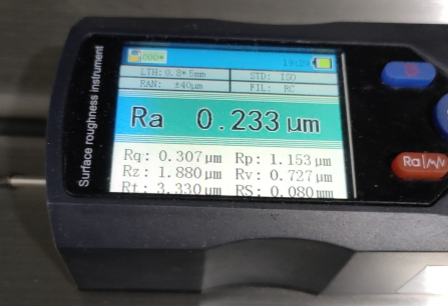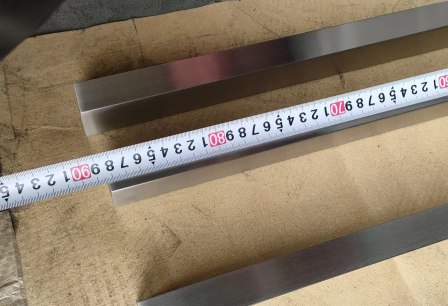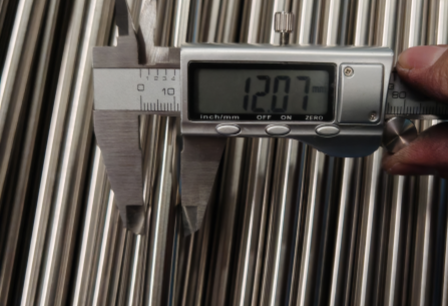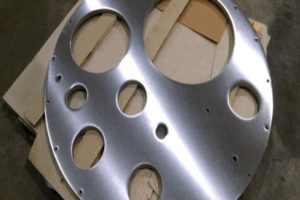Stainless Steel Polishing
Precision Shearing
Precision Sawing Services
Precision Waterjet Cutting
Laser Cutting
Other Service
Metal polishing smooths the surfaces of fabricated metal pieces such as sheets, angles, and pipes, often providing the final finish before parts or materials go to their end use. Polishing stainless steel is highly beneficial, as it noticeably improves its resistance to damage caused by corrosion, environmental factors, wear, and impacts.


Stainless steel can be more challenging to polish than some other metals, but experienced metal polishers can achieve smooth finishes without blemishes or damage. Hua Steel specializes in polishing a variety of stainless steel pieces, such as:
In addition to polishing, we offer end-to-end solutions for our clients. As both a fabricator and distributor, our team can convert raw materials into manufactured pieces, finish them, and deliver the order to your warehouse or distribution center.
For more details about the high quality stainless steel polishing services contact us directly or request a quote.
Once metal components have been machined, polishing is a critical finishing step for a variety of parts and components to improve the aesthetic appearance of the finished product. It also has several functional benefits, including:
The stainless steel polishing process contains between three and seven distinct stages to reach an ideal finish. Many of these stages involve using mechanical abrasive media—such as
Alumina, Zirconia and Ceramics in the process of surface conditioning.
The requested finishing standard impacts the number of stages involved in the polishing process. Operators can use abrasives ranging in grit strength from 50-3,000 to gradually increase the smoothness of the finish without damaging the product. The No. 8 finish—one of the highest finishes that provides a mirror-like smoothness—requires abrasive alumina powder.
Stainless steel is an ideal metal for a broad range of products and components, but it can be a difficult material to polish. This challenge is due in large part to two of the predominant characteristics of the metal:
Stainless steel develops an increased hardness the longer stress is applied to the surface—this is known as work hardening. This means polishing has to be fast and precise in order to complete the job before the metal’s condition changes and the abrasive agent no longer becomes appropriate. Expert metal polishing operators have processes in place to move quickly from step to step—or from grit to grit—without overworking the metal.
The passivity properties of stainless steel also require fast polishing speeds. The top layer of stainless steel oxidizes to keep corrosion and rust at bay. While abrasive polishing cuts through that layer, it is quickly replaced by a new layer of oxidized steel. The hardness of the new layer can disrupt the polishing process if operators aren’t moving fast enough.
Different grades of stainless steel can also simplify or increase the complexity of the polishing process. 304 is a basic type of stainless steel and one of the simplest to polish. 430, on the other hand, develops a hard oxidized surface layer and is more difficult to polish.
Steel Mill Process The term “Pickled” means that the material has been subjected to an acid solution that has been specifically developed to remove the high temperature oxides that appear on the surface after annealing.
A variety of finish types can be applied to most stainless steel. The different types are measured on a scale ranging from 0-10:
Hua Steel specializes in producing #3, #4, and #6 finishes, as well as Scotch-Brite finishes. Scotch-Brite finishes smooth a surface down to 20 Ra. Scotch-Brite metal finishing wheels and processes can achieve brushed, mill, and satin finishes.
While almost all polishing processes involve mechanical abrasion, there are a variety of different processes and tools that work on different types and shapes of metal. The most common polishing processes include:
Belt sanding tools—or belt grinders—mechanically rotate a belt of gritted material to abrade the surface of stainless steel.
The belts can have different levels of grit, including rough or low grit levels for the beginning stages of the process and fine or high grit levels for ending processes. The belts also come in different widths to handle different workpiece sizes.
When the edges of stainless steel pieces need to be polished, sufficient pressure needs to be applied to thoroughly polish edges in order to mitigate corrosion and contamination risks at high-contact points.
Polishing belts of zirconia / ceramic abrade polish stainless steel surfaces. These machines use different polishing grits that an operator may choose from.
Grinding is one of the most common metal polishing processes. Various types of grinding machines can finish different shapes of metal ranging from plates to pipes. While grinding is typically considered to be a rougher, separate category of metal finishing than polishing, it can erase surface-level imperfections and is often used during the beginning stages of polishing.



Angles.These pieces are polished for a clean outside appearance for manufacturing and architectural applications. The angles need to stay precise and unmodified for exact measurement and placement. Often, the material is rolled to a HRAP finish and then polished to a #4 finish.
Bars. Round bars often need a #4 or #6 finish for industrial and manufacturing purposes. Square bars may be finished with a #3 finish and then smoothed to #4 or higher.
Channels.Channels require relatively smooth external and internal surfaces, especially when intended for use in industrial equipment and conveyance systems.
Plates.Plates can be finished for a variety of functional purposes at a lower finish type. A higher luster finish can be achieved for applications requiring pleasing aesthetics using Scotch-Brite equipment.
Sheets. Light and heavy gauge is used in almost every industry. Polishing makes sheets aesthetically pleasing, more sanitary, and easier to inspect.
TubingPipe forms need to be polished to reduce the risk of external and internal contamination. Corrosion is more likely to form in rough internal surfaces where the fluid can wear past oxidized surface layers over time.
Stainless steel parts can be found in every industry as part of industrial equipment, architecture, and more. Hua Steel currently serves the following industries:
Hua Steel specializes in stainless steel polishing for consumables, discs, forgings, pipes and tubing, rings, and pumps across all industries.
Here is a summary of our most common stainless steel polishing services and capabilities:
In addition to premium polishing, we provide a full menu of value-added services including forming, bending, roll & weld, drilling, grinding, and other specialty processes. Typical turnaround times for polishing range from hours to weeks, and we handle prototype production up to volumes of hundreds of units. We pride ourselves on being a provider of turnkey solutions, so our value-added list of services also includes distribution and delivery.























At Hua Steel, we offer precision shearing services for a range of industries, utilizing advanced shearing equipment to effectively process sheet and plate forms of aluminum, stainless steel, bronze, copper, nickel alloy, high temperature alloys, titanium, and brass. We have a 144″ width by 0.625″ thickness sheet size capacity, handling weights up to 10,000 lb. and maintaining tight tolerances of ±0.010″ throughout production. Prototype to heavy volume production is available, with no minimum quantities required.
Quality is our culture, and all products are extensively tested and inspected with visual and dimensional methods, as well as surface and ultrasonic testing. A host of value added fabrication services are provided including welding, forming, rolling, heat treating, drilling, trepanning, stamping, and grinding among others. Our experience and extensive product knowledge ensures customer satisfaction; rather than offering stock items, we work with each client to produce their ideal product.
At Hua Steel, we provide turnkey metal solutions. From sourcing the raw material to converting and finishing it, we deliver metal ready to use in manufacturing projects.
Precision sawing—also referred to as precision saw cutting—is one of our specializations. Using the process, we cut a variety of materials in bar, pipe, plate, and tube form. Regardless of whether a customer needs small or large parts or a prototype or production run, we can meet their needs with quality cut products.
Our Precision Sawing Capabilities
Our precision sawing capabilities accommodate a variety of customer project specifications.
Sawing Capabilities
Our state-of-the-art fabrication facility allows us to handle:
We use precision sawing to cut a variety of metals in bar, coil, sheet, plate, and tube form, including:
In addition to our precision sawing capabilities, we also offer several value-added services to facilitate the delivery of a fully finished, high-quality metal part. These services include:
Every part we produce is also subjected to comprehensive inspection and testing to ensure both quality and accuracy. These procedures include visual and dimensional inspection and surface and ultrasonic testing.






Metal sawing is a manufacturing process that employs a saw blade to cut a large metal workpiece into smaller pieces. It finds application across a wide range of industries as a cutting method for a variety of materials, ranging from aluminum to titanium. Depending on the requirements and restrictions of the cutting project, industry professionals use different sawing methods.
There are two primary saw cutting methods employed by manufacturers today:
Circular saw cutting. In this technique, a circular blade spins as it cuts through the workpiece. Many circular saws are designed for rigidity and reduced vibration levels, which means that manufacturers can cut parts faster and with more precision.
Band saw cutting. Band saw machines contain an extended straight blade that has evenly distributed metal teeth. Band saws provide uniform cutting action and high precision results and are highly suitable for cutting workpieces into irregular or customized shapes.
Waterjet cutting is used by metal processing specialists to form highly accurate cuts for custom metal components. It is a cold-cutting technique that leverages water (or a mix of water and abrasives, such as garnet) to cut through materials via rapid erosion. This process is suitable for cutting a variety of materials—ranging from soft products like foam and carpet to hard metals like ceramic and metal—and can cut through materials up to 8 inches thick.
Unlike laser cutters or plasma cutters, waterjet cutting tools do not rely on thermal mechanisms; instead, they eject water at three times the speed of sound. The pressurized water stream magnifies the effect of erosion to quickly and cleanly produce the necessary cuts on the material.
In support of our metal sourcing, distribution, and fabrication services, At Hua Steel is proud to offer precision water jet cutting services with bevel cutting capabilities. Custom shapes are cut from stainless steel, nickel alloy, titanium, aluminum, copper and brass, in sheet and plate raw forms.
For more information about our advanced water jet cutting processes or the other responsive and dependable metals manufacturing services we provide please see the table below or contact us directly.
Compared to other cutting methods, waterjet cutting offers numerous benefits, including:
No heat affected zone: As mentioned previously, waterjet cutting is a cold-cutting technique that does not require material to be heated or stressed with machinery. This lack of thermal input means that there is little to no heat affected zone (HAZ) — which decreases the risk of thermal distortion, such as warping or impurities in certain materials.
Waterjet cutting can be used on a wide range of materials, including glass, paper, metal, foods, composites, mixed materials, and more.
Waterjet cutting can cut parts with better tolerances, especially on thicker materials.
Since waterjet cutting leverages water and recyclable abrasives, you do not have to deal with slag byproducts that can be produced by other cutting methods, such as laser or plasma cutting.
Waterjet cutting produces a fine sand-blasted edge finish, which can sometimes eliminate the need for finishing services.
Jiangsu hua steel groop CO., LTD Metals offers waterjet cutting services to form custom shapes from a variety of materials, including:
Our advanced waterjet equipment produces a stream capable of cutting thicknesses up to 6” for both metal sheets and metal plates.
The 5-axis waterjet cutting machine allows us to produce cuts on materials in virtually any orientation and at any angle (ranging from 0 to 90 degrees). This capability enables consistent and reliable production of complex and intricate parts, including those requiring beveling and contouring.
Waterjet cutting and multi-axis waterjet cutting operations are used throughout industry for a variety of cutting applications. Some of the industries in which they are commonly used include:
In addition to waterjet cutting, Hua Steel offers another popular metal fabricating technique: laser cutting. While both of these techniques are highly versatile and suitable for a wide range of applications, there are some key differences to be aware of when choosing between laser cutting and waterjet cutting:
Material range: Laser cutting is better suited for materials that are not highly reflective, while waterjet cutting can be used on almost any material.
Material width: Laser cutting is best suited for thinner materials, while waterjet cutting can handle materials up to 8 inches in thickness.
Precision: Laser cutting can produce higher precision cuts than waterjet cutting. Laser cutting has a processing tolerance in the +/- 0.001–0.003 inch range (depending upon the job), while waterjet cutting typically ranges from +/- 0.003–0.008 inch.
Waste and noise production: Waterjet cutting is noisier and creates more waste byproduct than laser cutting.
Thermal distortion: Waterjet cutting does not produce heat damage on materials, while laser cutting can cause some heat damage. Typically, these heat marks can be cleaned and removed post-cut.
Engraving capabilities: Laser cutting can handle detailed engraving projects while waterjet cutting cannot.
3D: With multi-axis cutting equipment, waterjet cutting tools can cut in 3D while laser cutting is typically restricted to 2D cuts.
Custom Metal Fabrication with Waterjet Cutting at Jiangsu hua steel groop CO., LTD Metal While waterjet cutting may be the best method for your component, Hua Steel recognizes that your project’s needs are specific. That’s why our team is happy to review your project’s design and determine the best method — whether it’s waterjet cutting or laser cutting, or another metal forming service that we offer.
We offer a variety of testing and inspection procedures (e.g., surface and dimensional, ultrasonic testing, visual inspection, etc.) to ensure the quality and integrity of your metal component. We also offer value-added services, such as bending, boring, centerless grinding, double disc, grinding, drilling, forming, heat treating, rolling, stamping, and trepanning, to help you produce a fully finished part.



To support our turnkey solutions for metal products, Hua Steel offers precision metal laser cutting services. Some of the typical products that we’ve applied laser cutting to include aircraft engines, cleanrooms, consumables, discs, forgings, pipes, pumps, rings, and tubing.
Our laser cutting services delivers ultra-precise cuts, edges and holes on a variety of metal materials. Combined with our stainless steel polishing and finishing services, these capabilities allow us to produce a wide range of custom shapes and designs from prototype to full volume production runs — with no minimum quantities.
In addition to cutting precision, laser cutting can offer additional benefits such as lower manufacturing costs, as the laser does not wear and no tooling is required.Hua Steel can laser cut components with the following capabilities/specifications:
Laser cutting is a highly accurate process that uses a computer to direct the beam of a high-powered laser at the workpiece material. The term is slightly misleading in that the laser “melts” rather than “cuts” the metal, but the end result is a high-quality and precise edge. Laser cutting offers the following advantages over traditional metal fabrication methods:
Laser cutting finds application across a wide range of industries, including:
To further facilitate the delivery of a complete solution, our customers take advantage of our comprehensive range of value-added services on top of our stainless steel polishing capabilities, including:



HUA Steel specializes in the distribution of stainless steel, nickel, titanium, and hard-to-find metal alloys. In addition to our core shearing, sawing, waterjet cutting, laser cutting, and polishing capabilities, we offer a variety of value-added metal processing services to ensure customers receive materials that meet their needs. One of our secondary service offerings is heat treatment.
Heating treating involves heating and then cooling a material under carefully controlled conditions. This process enhances the properties of the material to improve its performance in the target application. For example:
While the conditions of the process can vary with regard to temperature (as high as 2,400° F), heating time (a few seconds to several days), and cooling time (gradual to quick), the general basics remain the same from operation to operation.
There are a number of heat treatment processes available, each of which results in different final properties in the material. AAA Metals offers four types of heat treating services:
Our heat treatment experts accommodate the following metals:
We are proud to offer metal heat treating services to customers in a wide range of industries, including, but not limited to, the following:
Whether they require metal for aircraft engines, clean rooms, consumables, discs, forgings, pipe, pumps, rings, or tubing, we can provide them with a material solution that suits their needs.
Many of the industries we serve are subject to strict standards that necessitate a high level of quality in parts and products. We can process our materials to meet a variety of industry standards, including: